FILM MUSIC RECORDINGS REVIEWS |
|
|
FILM MUSIC RECORDINGS REVIEWS |
|
|
March 1999 Part 2
© Film Music on the Web 1999. All rights retained. Reviewers retain copyright on their reviews. Disclaimer
![]() COMPETITION WIN
a CD of your Choice from Crotchet
COMPETITION WIN
a CD of your Choice from Crotchet
![]()
Christopher FRANKE Babylon 5 - Thirdspace OST
SONIC IMAGES SID-8900 [59:25]
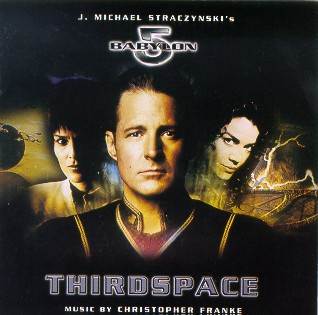
I am afraid that the addition of an ondes martenot is not, by itself, going to make the finest film or TV music. Franke writes competent atmosphere music, hissingly sinister or weirdly minatory. In this case however its entertainment value exists only when heard or overheard with the Babylon 5 series. I am not out of sympathy with Babylon 5 and have quite enjoyed the series on TV (especially in the early days) but that is not enough for me to recommend this disc to other than devoted Franke collectors or total Babylon 5 enthusiasts. The notes focus on the instrument and recall Herrmann's use of it in The Day the Earth Stood Still. The music falls very far short of that example.
Reviewer
Rob Barnett

John BEAL The Funhouse OST
JNBL 4001 [38:37]
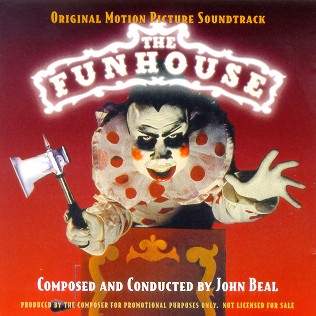
The Funhouse, made in 1981, is described by Halliwell as - "a violent, freak-show horror that tries for black humour but misses most of the time; it sticks to the usual equation: teenage sex equals gruesome death." The colorful CD leaflet cover showing a grotesquely-grinning, malicious clown figure emerging jack-in-the-box like and holding a hatchet sums it all up. Apparently it is a now regarded as a cult classic.
John Beal's dark, Gothic score, nodding towards Bernard Herrmann, and anticipating Danny Elfman, is impressive and it gets a robust performance in this new recording from the composer's contract players.
A solo piccolo announces the rather plaintive but soon shrill-sounding three-note motif from which much of the score is built but this is quickly crushed by harsh emphatic chords from the orchestra before we are whisked into a wild carnival atmosphere. This music develops into an almost Ravelian waltz (which becomes ever more twisted and demented in the cues "The Funhouse"and "Chained Melody") The atmosphere then relaxes, but not for long because creeping, menacing string figures emerge that grow more and more menacing until we have the sort of shrill stabbing chords associated with the shower scene in Psycho but with little flashes of xylophone colouring. All this material is contained within the Main TitleTrack 1!
In "God is watching You" (surely an ironic title) Beal uses edgy metallic electronic instrumentation to screw up the "don't look-behind-you" suspense, together with quieter more reflective music. "Carnival Skyline" offers some welcome if brief serenity; it's an evocative and atmospheric portrait with just a hint of threat. I will not tire you with a complete track by track analysis, the score continues in much the same vein, but Beal's score is resourceful and he weaves enough variety using electronics skilfully interwoven with his conventional instrumentation to continually screw up the tension until it climaxes noisily and terrifyingly in "The Funhouse" and "Chained Melody" cues. Often he will use some little surprise staccato grotesque effect to spine-tingling effect.
An above-the-average horror score. It is a pity that Mr Beal was not served with mo re complete documentation than the scanty one-page leaflet that serves as the CD booklet.
Reviewer
Ian Lace
tar.gif)
Paul Tonks adds:-
If you’ve made up your mind one way or the other about composer John Beal on the strength of the Coming Soon ! collection, you need to obtain this at the double so as to be able to make up your mind all over again. That set of trailer themes in no way prepares your thinking for a fully developed score. The bitty nature of that listening experience has you latching onto favourites, and then wishing there were more. Here Beal flexes every muscle, and fulfils the promise of the "Main Title" to give you a thematically rich score. Being a horror film, there’s plenty of spooky invention too.
Hailing from 1981, this promo speaks volumes of the opening of that decade, when full orchestrations won out over electronic experimentation. All the way through this disc, there is a delightful sense of large proportions. It’s a busy score, with fast and frenetic passages ("The Funhouse") building up a constant sense of unease.
I am a bit of a sucker for the carnivalesque waltz too, so to hear it implicitly or by suggestion under the harp glissandi and rapid fire drumming is a personal treat. The ‘Big Top’ sound can easily come off as cheesy, but the necessary chill quota for a horror really puts paid to that. Danny Elfman enjoys the sound as well, and it’s nice to see someone else having macabre fun with the genre long before he came on the scene.
Reviewer
Paul Tonks

This CD carries the message: "Produced by the composer for promotional purposes only. Those interested in acquiring a copy should visit John Beal's web site on: http:www.beal-net.com/john/
Billy MAY Johnny Cool OST
RYKO RCD 10744 [31:47]
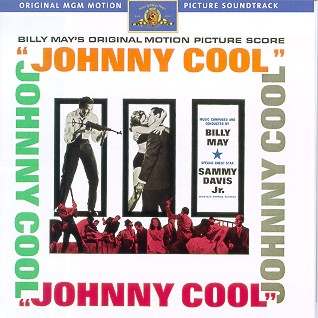
The music on this CD was recorded in 1962/3 for the gangster movie "Johnny Cool", the stars of which were Henry Silva and Elizabeth Montgomery. This is an album of high quality big band music from Billy May and an orchestra of top session players assembled for the purpose. Billy is synonymous with excellence in big band orchestration. By today’s standards these tracks are mostly fairly short (less than 3 minutes), but the arrangements and the musical performance are of the highest standard. As the leader of a big band, I would consider it a great privilege to have these arrangements in my library and would love to have the opportunity to play them.
Billy May is now 83, but he still travels around the world playing concerts of his compositions and arrangements. He was recently in action with the BBC Big Band and anyone who heard the broadcast will testify that it was something special! Having learned his craft as a Trumpet player in the bands of Les Brown and Glenn Miller, Billy May turned his attention to Composing and Arranging and since that time he has never looked back. This album is a fine example of his work and should be in the collection of every serious big band music fan.
The first track The Lizard has a groovy theme with a Tenor solo by Justin Gordon, one of the few names listed on the information sheet. There were so many sessions in those days that no one can remember who played on them! The Window Washer has a well-written intro. some precise section work, the drumming is very crisp and there are some real screamers from high note Trumpet man Bud Brisbois. Dave’s Affair is a slower track with some fine Alto playing in the style of Johnny Hodges. Borrow A Knife reminded me of Slaughter on Tenth Avenue, the band really swings on this one. Johnny Cool Theme has a two beat feel, slurping Saxes, more Trumpet high notes and a more up-tempo second section. Morning in Bolboa has the rhythm section playing in the style of the George Shearing Quintet. This track has a very relaxed feel and a great ensemble sound. The Shearing influence continues in Nice Quiet Saloon. There is a very well played muted trumpet solo from West Coast Trumpet player Don Fagerquist. Green Tables Blues is in the style of Bill Basie and there is nothing wrong with that! The Coolest Pad is just that, Tenor lead for the Saxes, superb ensemble playing and a very musical arrangement. Juan Coolistico, a Latin theme, plenty of clean percussion here, nice flute solo against riffs from the band. Sammy Davies JR. joins the Band for the last two tracks and gives his usual polished performance on Bee Boom, a Billy May original and the title track Ballad of Johnny Cool.
I don’t know what the film was like because I haven’t seen it, but the music is first class!
Reviewer
Don Mather

Johnny MANDEL I want to Live OST
RYKO RCD 10743 [59:22]

Any CD, on which the composition and musical direction is by Johnny Mandel, is always worth hearing and this one is no exception. The album is in two parts; the first consists of 16 short tracks that were used in the soundtrack on various sequences of the film. They are played by a 26 piece studio orchestra which included Bill Holman on Tenor and Baritone saxes, Jack Sheldon on Trumpet, Russ Freeman on Piano, Larry Bunker on Vibes and Drums and Abe Most on Clarinet.
The arrangements are impressive, the musicianship immaculate, but I have to confess that sometimes for me, film music taken out of it’s context, has a strange feel about it.
Part two however is absolutely the kind of music I like best.
Johnny Mandel’ s imaginative compositions and arrangements for a Septet led by Gerry Mulligan are a recipe for musical enjoyment. The Septet is completed by Art Farmer on Trumpet, Bud Shank on Alto and Flute, Frank Rosalino on Trombone and a superb rhythm section consisting of Pete Jolly on Piano, Red Mitchell on Bass and Shelly Manne on Drums. Rhythm sections don’t get better than that! Gerry Mulligan was a jazz giant who will be sadly missed and on this session, the combination of Johnny Mandrel’s imaginative arrangements and a group of the very best jazz musicians playing at the top of their form, produce a stunning result. The rhythm section in which Pete Jolly is superb is one of the best I have ever heard. In summary, a very interesting release, particularly the jazz combo, which is an absolute joy!
Reviewer
Don Mather

Roy BUDD Get Carter OST
CINEPHILE/CASTLE CIN CD 001 [54:17]
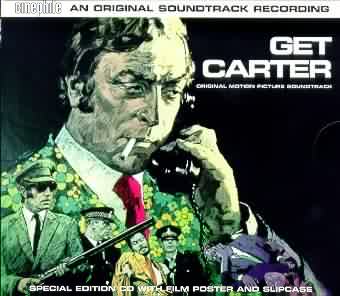
Tragically, British film composer, Roy Budd died in 1993 at the early age of 46. Roy Budd was a respected Jazz musician before he turned his hand to film music. Born in Surrey, just south of London, he began working professionally at a very early age with engagements at the London Palladium at the age of 12 (in fact he had been nicknamed - "the Mozart from Mitchum"). He was respected as being a brilliant musical improviser. His music combined jazz with contemporary pop music.
Now Cinephile have issued a collection of his scores. The first of these is given the special presentation treatment with a cardboard slip case and largish film poster. This is appropriate for his music for Mike Hodge's British gangster film, that has been compared with the best of Hollywood in the genre, is Budd's masterpiece.
The film concerns Carter's vengeful visit to his old hometown, Newcastle, to seek out the villains who had killed his brother. Michael Caine was brilliant in the role of Jack Carter; cold and laconic with a bitter, caustic wit, yet vulnerable too. He was supported by a marvellous supporting cast including Ian Hendry as Eric. Remember their dialogue at the race track? Jack:...I'd almost forgotten what your eyes look like. They're still the same - like two piss holes in the snow." Eric: "'Still got a sense of humour!" Jack: "Yep. Yes, I retain that, Eric!" The race track dialogue, and eight other dialogue snippets are interspersed with the music on this CD. [The film's supporting cast also included John Osborne, Glynn Edwards, Bernard Hepton and Brian Mosely (British soap opera Coronation Street's lately deceased Alf Roberts) who fans will remember as the man that Carter throws off the top of a multi-storey car park.]
Who could forget the brilliant, steely-hard Carter theme, a two-note, pause, two-note motif played on the harpsichord with the added sound of strumming fingers across piano strings. This is stated right at the beginning and developed in a great jazz improvisation played against Carter's train journey northwards from London to Newcastle at the start of the film. Train noises are also included in the cue; and notice how appropriately and how well they blend with the music, the tempo of which slows as the train arrives at Newcastle. Budd's score blends jazz and early 1970s Pop music into a wonderful mix, creating memorable cues all the way through this album. (An indication of the esteem in which the original soundtrack LP was held is the fact that a copy recently fetched £1,500 at auction!) It is salutary to realise that this score was brought in for only £450! The players and instrumentation are economical: just Roy Budd with Geoff Cine (bass) and Chris Careen (drums and percussion), plus vocalists. The songs are all vibrant and memorably melodic: "Looking for Someone"; "Something on My Mind"; "Getting Nowhere in a Hurry"; and "Love is a Four Letter Word" all of them making ironic commentary on Carter and the storyline. A very firm recommendation
Reviewer
Ian Lace
tar.gif)
As Budd's career developed his music supported a wide variety of screenplays proving his adaptability and versatility. Below are briefer reviews of another five of his scores by Ian Lace and Rob Barnett:-
Roy BUDD
Fear is the Key
OST
CINEPHILE/CASTLE CIN CD 002 iMVS (UK) [36:15]
Diamonds
OST
CINEPHILE/CASTLE CIN CD 003 iMVS (UK) [47:29}
The Black Windmill
OST
CINEPHILE/CASTLE CIN CD 004 iMVS(UK) [40:33]
Sinbad and the Eye of the Tiger
OST
CINEPHILE/CASTLE CIN CD 005 iMVS (UK) [1:53]
Paper Tiger
OST The National Philharmonic Orchestra conducted by the composer
CINEPHILE/CASTLE CI N CD 012 iMVS(UK) [50:51]
Sinbad has been the subject of scores from Bernard Herrmann (The 7th Voyage of Sinbad) and Miklos Rozsa (The Golden Voyage of Sinbad) - both reviewed recently on this site. It is instructive to compare these two with Budd's music for the last and least regarded of the (cheaply produced) Ray Harryhausen epic. For Sinbad and the Eye of the Tiger (1977), Although not in the same class as his illustrious peers, Budd, nevertheless, delivers an enjoyable, racy score as colourful and Arabian exotic as Rozsa but more straightforwardly melodic than Herrmann blending ardent love music, comic characterisation and the more horrific, grotesque for the obligatory monsters.
Reviewer
Ian Lace

Alistair Maclean's novel, Fear is the Key (1972), made an uneven transfer to the screen. After the edge-of-your-seat car chase in the first half hour it was down-hill all the way. Budd provided an upbeat jazz-based score with one of his attractive long-spanned melodies announced in the Main Theme. The most significant track here is the music for that car chase; ingenious in its pacing, mood and evocation (the strings realistically depicting screeching tyres), but the inclusion of actual car noises as the track proceeds can become very tedious on repeated hearings. The remaining tracks offer easy trad jazz listening in various tempos mixed with some interesting variations on the darkly menacing materials with which we have grown so familiar.
Reviewer
Ian Lace

Paper Tiger (1975) starred David Niven as the tutor to the young son of the Japanese Ambassador to an unspecified Far Eastern country. Niven, the paper tiger (coward) of the title spins fictitious tales about his non-existent war exploits, but when tutor and pupil are both faced with real danger, the Niven character first flunks and then rises above his fear to become a tiger proper. Roy Budd created one of his best scores for this film. The opening Main Theme contains one of his loveliest melodies that can persist in the head for days. This is followed by authentic-sounding Japanese - beautifully innocent - music for "Teacher and Pupil". Niven's character is shaped by a waggish, swaggering version of "The British Grenadiers", and the suspense/combat music is well handled. Another subsidiary melody is also included and it is good to hear The Ray Coniff Singers and the Mike Sammes Singers again. Budd has all the advantages of the splendid playing of the National Philharmonic Orchestra (used by Charles Gerhardt for his RCA Classic Film Scores series).
Reviewer
Ian Lace
tar.gif)
Budd's music is polished and knife-edged whether in a cool dreaminess or icy threat. It is rather continental (Italian) in feel. This music is definitely worth hearing as representative of the 1970s. Diamonds with its cold, quietly-cutting charm is striking. This is most obvious in the title tracks as well as in Crown Jewels and A Handful of Gems and the end-titles.
Along the way you get some all-purpose Persian market music which cuts little ice with me: Budd marking time. The Three Degrees (and no doubt fans will be seeking out this album as well as Budd collectors) are in excellent voice and are recorded in an ambience that glistens and shivers
Reviewer
Rob Barnett

The Black Windmill is a film which has been shown quite a few times on television so people may well remember Michael Caine as the go-it-alone secret agent who, to save his child, takes on enemies on both sides of the ‘wall'. The score has some of the quiet and freezing charm (In the Garden) of Diamonds but is interspersed with some fleet-footed jazz trio passages. Overall though the score does not hold up as well as Diamonds though the climactic gestures of No Co-Operation make the album worth hearing. Both Diamonds and Windmill are very well documented - a great credit to the enterprise. There are plenty of stills and original poster-art is used. Sadly The Black Windmill instead of using the durable booklet format, uses the fold out movie poster facsimile. This is fine for short term impact but guarantees a short life for the insert. Playing time is short. Enjoyable but not utterly compelling.
Reviewer
Rob Barnett

Trevor RABIN and Harry GREGSON-WILLIAMS Enemy of the State OST
HOLLYWOOD HR-62160-2 [54:12]
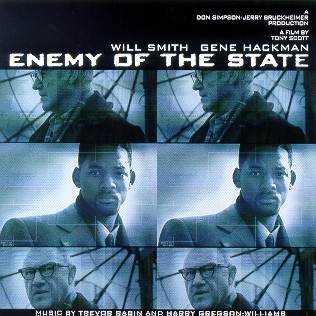
I emerged from listening to this album wishing it had only lasted 4 minutes instead of 54! The pounding scraping electronics, in all the usual action/thriller modes were just too much. Usually they were mixed with slow, low string accompaniments - I pity the poor cello and double bass players for much of the time they only had to move their bows minimally. Occasionally like in "Coal Yard" the violins have a chance to play in quick agitated figures. This is all a pity because two early cues "Enemy of the State Main Theme" and "Brill's Theme" do show promise the acoustic instruments playing in the former a rich romantic theme and, in the latter, some interesting pensive material
Only for synthesiser music fans and even for them I would caution listen first before buying.
Reviewer
Ian Lace
tar.gif)
Richie BUCKLEY The General Music Written, Arranged, and Performed by Richie Buckle
MILAN 73138-35863 [37:54]

Initially, jazz was an African-American musical style, but it soon became a popular form through the Western world. Recognizable by its rhythmic structure, improvisation (or, at the very, suitability for the same), and the playing of notes below pitch, it is a style of music that is specifically non-specific. Although he did not make the introduction to cinema, many hold renowned film composer Alex North as the man responsible for making jazz respectable as a style of filmusic. Jazz so perfectly suits film that it boggles the mind to wonder why earlier composers dismissed it so swiftly.
Richie Buckley's jazz score to "The General" is no doubt an acquired taste, but its support of John Boorman's film about Martin Cahill, a famous Irish criminal, is nearly indispensable. The music feeds off the stereotypical perception of jazz as a sleazy musical idiom, creating conflicting images of class and irony. Like the black and white cinematography the film utilizes, the music emphasizes the characters and story rather than flooding them with atmospheric mimicry. The lack of specifics in the underscore fleshes-out the details of the film.
The score does best in the realm of evocative ostinatos and motives. While the themes are present, they are short-lived, quickly used and disposed of. The recurring piano ostinato that opens the soundtrack is the closest thing to a leitmotif the score has to offer. Because of the nature of the soundtrack, much of the score seems to run together on the album. This is the composer's fault. It is a fantastic score with discernible ideas, but they mesh almost too well.
One of the defining characteristics of film music is the ever-changing mood, the disparate pulse of the music as it moulds itself around visual cues like scene changes, knife slashes, or a woman's batting eyelashes. But "The General" sounds little different from an average jazz recording. This works. However, for the die-hard filmusic buff there is an audience that Buckley does not address. Of course, there is no rule stating he must address any style other than his own, but filmusic fans expecting a traditional film score -- or, for that matter, a traditional jazz film score -- may wish to listen before buying.
The musicians, all of whom turn in strong performances, are Mick Kinsella & Philip King (harmonicas), Stephen McDonnell (trumpet, flugelhorn), Michael Buckley (alto flute, tenor saxophone), Karl Ronan (trombone), Carl Geraghty (baritone saxophone), Ronan Dooney (trumpet, flugelhorn), Niall O'Neill (bass guitars), Paul McAteer (drums), Bernard Reilly (percussion), Brian Connor & Pat Fitzpatrick (keyboards), Robbie Overson & Arty McGlynn (guitars). Richie Buckley himself plays solo baritone saxophone.
Reviewer
Jeffrey Wheeler

Michal PAVLICEK The Scarlet Pimpernel (Music from the BBC TV Series) BBC WMSF6002-2 [69:43]
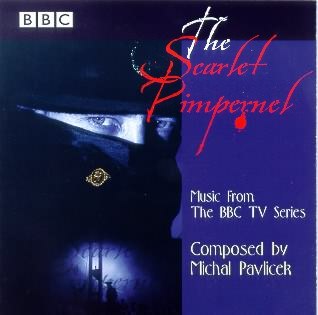
Pavlicek is a name new to me. I am glad to make the acquaintance of his music. This is sly, sardonic, venomously humorous, occasionally rather sleazy and misty. Grand drama and romance are there too. The notes are very full - excellent.
After complaining for years about short measure I must confess that I thought that almost 70 minutes of Pavlicek was too much. The trick is not to listen to it in a single session.
I hope that the BBC commission more scores from this composer. We should watch for this name: a rising star.
Reviewer
Rob Barnett

Siân JAMES Birdman (Aderyn Prin) Siân James and instrumentalists
BBC WMSF6007-2 [55:03]
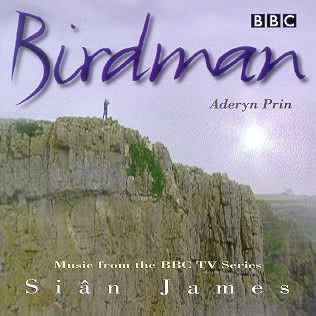
This is an enchanting collection which I recommend warmly.
Birdman is a new six-part series made for BBC Wales, to be shown in te UK from late February. It is about an RSPB officer's conservation work protecting endangered species including birds of prey, grouse, lapwing and seabirds.
Welsh artist Siân James, who has composed the music for the series, is also heard on this soundtrack CD as singer and instrumentalist. She is steeped in Celtic music. As a child, she studied piano, violin and harp. She began performing in concerts at fourteen and formed the popular folk/rock group Bwchadanas whilst at university. Her composition professor was William Mathias. Her other TV and film work includes singing on the score for The Englishman Who Went Up a Hill and Came Down a Mountain.
Writing about her Birdman assignment in the CD booklet she comments "There was something appropriate about asking a Welsh traditional singer to compose a soundtrack with birds as its theme. The reason being that birds have always played a significant part in the Celtic culture of Wales. They play a central role in several of our legends - eg.Blodeuwedd, Branwen and Rhiannon. Birds were also relied upon to foretell events. There are countless sayings in the Welsh language that refer to the flight paths and other activities of birds as being indicative of present and future events. And of course our folk songs are littered with ornithological references, the Ilatai or messenger song (where young men send birds to their lovers to ask them if they love them) is one of our most common types of traditional song."
The nineteen numbers here embrace mainly the Celtic tradition and employ traditional instruments but some have a slight seasoning of modern electronic instrumentation but not so much as to be inappropriate and intrusive. Pipes, piano and harp are dominant and most of the songs are sung in the Gaelic language. One or two of the numbers lean strongly towards the pop rock culture and one, "Rhodio", has a strong Afro-Caribbean flavour. Most are serene and relaxing and frankly sweetly nostalgic. This is easy listening and I do not mean to be at all disparaging, on the contrary these numbers demonstrate an impressive musical facility. So, turn out the lights, throw a log on the fire and sit back and dream.
Reviewer
Ian Lace

And Rob Barnett adds -
I was very pleased to have the opportunity to review this disc although being television-less at present I have not seen the series. My pleasure is related to my interest in the development and popularity of Celtic music in the popular field.
The crossovers and links between the work of Karen Matheson (she of the golden voice in Capercaillie and a phenomenon) and of Siân James struck me with some force. If I prefer Ms Matheson’s voice it is clear nevertheless that Siân James has a voice of crystalline purity and sorrowing plangency. The accompaniments are typical of the work of Capercaillie though I am pleased to say that there is less synthetic treatment for Ms James’ instrumental accompaniments. Truth to tell the songs are not as memorable as those of Capercaillie but they strike with some soft beauty on the ear and are worth your time. A gentle album of under-stated melodic poetry. Recommended and definitely listenable separate from the TV series.
Reviewer
Rob Barnett
tar.gif)
Collection GREATEST SCIENCE FICTION HITS Vol IV Neil Norman and his Cosmic Orchestra
GNP Crescendo GNPO 2258 [79:15]
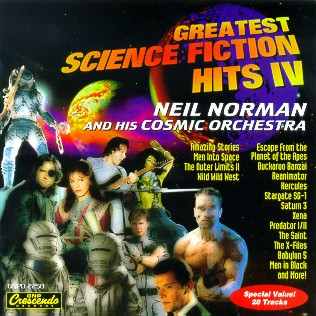
As you will note from the timing above this is a very full and generous programme, with no less than 28 tracks!. It is also a very exhausting one. I commend it more to the younger visitors to this site. Most of the music is relentlessly strident. The opening two or three selections set the pace heroic full of heraldic brass and pounding drums. The album boasts a 60+ orchestra but I doubt whether this is utilised in all the tracks. Many of the later ones seem to be rock/jazz/pop driven with guitars and electronic instruments and synthesisers. The conductor is Jack Smalley who scored Charlie's Angels, Murder, She Wrote and Knight Rider. He contributes one of the most attractive tracks a special composition, Alien Autopsy which impressively eschews all electronics in favour of good old acoustic instruments to get the desired "other worldly effects - except for the use of the theremin at the end.
Variable arrangements of the music of John Williams, Jerry Goldsmith, Elmer Bernstein, Alan Silvestri, David Rose, Danny Elfman and Mark Snow are included. Interestingly there is a cue entitled The Wild, Wild West by Richard Markowitz (for the CBS series) which reminds us that science fiction tales can be likened to cowboys riding to the stars. Other TV series favourites included are: Xena: Warrior Princess and Hercules: The Legendary Journeys, Joseph LoDuca's fun scores, British TV The Saint theme and of course the X-Files given a cranked up treatment to include slithery alien evocations. The Lost World: Jurassic Park - gives us atmospheric jungle evocations and breathing, steaming monster effects and curiously Bernard Herrmann's Psycho music seems to have been resurrected for Reanimator. Uneven but fun for the youngsters
Amazon lists three albums by Neil Norman and his Cosmic Orchestra:
Greatest Science Fiction Hits Vol. 1 Vol 2 Vol 3
Reviewer
Ian Lace
tar.gif)
Collection LISTEN TO THE BAND: Stage and Screen Gems Various bands
BBC Music WMEM 0029-2 [67:18]
Robin Hood Prince of Thieves; Gabriel's Oboe; Devil's Galop; My Fair Lady; A Bridge too Far; Theme from Independence Day; Singin' in the Rain; Slaughter on 10th Avenue; Those Magnificent Men in their Flying Machines; Tonight; Mack and Mabel; Song of Freedom; Riverdance.
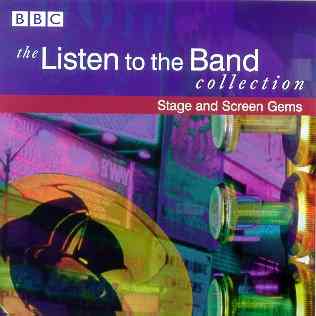
Not being a brass band enthusiast, I will admit that I approached this collection with some trepidation but I was very pleasantly surprised for practically all the performances on this disc are first class. They are played with great enthusiasm and panache. The most successful selections are those from the musicals with the exception of Tonight which has sounds surprisingly dour and sour in this too-clever arrangement. The Robin Hood fanfares are thrilling so too are the swaggering martial strains of Richard Addison's A Bridge Too Far. For older listeners there is the old BBC favourite The Devils Galop, a sort of James Bond of the 1940s radio. Gabriel's Oboe is a compelling poignant work which introduces the oboe and harp to a sympathetic band accompaniment. Only the Riverdance music sounds wildly out of place in the transposition on this disc
Reviewer
Ian Lace

Mike POST and Pete CARPENTER The A-Team Conducted by Daniel Caine
SILVA SCREEN STD-5020 [36:56]
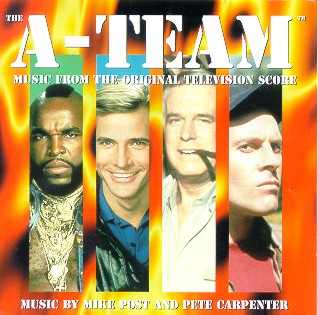
The early 1980s brought a plenteous supply of little-or no-brainer action television -- shows like "Simon & Simon," "Whiz Kids," "Airwolf," "KnightRider," and, perhaps most notoriously, "The A-Team." For me, it was a period of guilty pleasure. Hardly pinnacles of educational or inspirational television, youngsters of the '80s soaked them up all the same.
The music by Mike Post and Pete Carpenter is just as much a guilty pleasure. Episodic in nature, it never melds to form a true score with a sense of direction or purpose. However, the music adaptation by Derek Wadsworth helps make the individual tracks more 'wholesome,' notwithstanding that word being a less accurate description than one could use; yet it is close enough. The result is a theme and variations approach that serves the disc well. Quite frankly, the populist facets of the soundtrack can (and presumably should) become annoying, if not headache inducing, to anyone with good taste in music. Regardless, the electric guitars, drums, and pop mentality are what help make the album so enjoyable. Hearing the wonderfully typical "A-Team" theme performed with a disco beat halfway through the album is mildly surreal, unbelievably cheesy, and ultimately a perfect musical summation of the TV show. Perhaps I am biased because it brings back so many memories of my formative years, but I thoroughly enjoy this excursion into television's campy past.
The production design is minimal, while the instrumental performances and recording lack power and skill. I still enjoy it...Fear for my critical integrity prevents me from praising anything that is so bad, or at least so average, as to be good. But even the staunchest critic must have a few guilty pleasures for traditionalists to gawk at. "The A-Team" is one of mine.
Reviewer
Jeffrey Wheeler

On the other hand Rob Barnett comments:-
Silva have done it again! Those industrious people have located the OST (15 tracks) for the cult 1980s TV series The A-Team. The Stephen J Cannell Productions’ series was distinguished by its bloodless brand of jokey mayhem. It is utterly trivial fare decked out with the talents of George Peppard and his trio of loopy, charming and hard-done-by mercenaries acting like mobile Robin Hoods. As for the music I will not say much except that it fitted its task (the highest praise really). It is brash and jazzy. Its orchestral textures are disrupted and dominated by 1980s disco-style beats and militaristic side-drum figures. There is one main theme that is instantly memorable (which, after all, is what it is all about). But this is not a score you will be tempted to come back to for its stand-alone musical virtues. It has none. For die-hard A-team fans and collectors of scores for cult TV series. Celebrate however that scores like this are available for those who would like to have them. The market is well and truly pluralist. Now how about an album of music from The High Chaparral and The Virginian? While you are at it how about the positively Respighian theme from Dynasty.
Reviewer
Rob Barnett

Curio Corner
Howard HANSON (1896-1981) SYMPHONIES Nos. 1-7 etc. Carol Rosenberger (piano); Gerard Schwarz conducting The Seattle Symphony, The Seattle Symphony Chorale and the New York Chamber Symphony.
Two Volumes of 2CD albums - DELOS 3705 [135:48] and DELOS 3709 [138:17]
I first came across the name Howard Hanson, many years ago, when I impulse purchased the Charles Gerhardt/RCA recording of the composer's Second 'Romantic' Symphony on the basis of having enjoyed Gerhardt's Classical Film Score recordings. I wasn't disappointed; in fact I was bowled over by this unashamedly Romantic music. I then determined to seek out more of Hanson's music.
David Hall writing in Stereo Review commented, "Even more than Samuel Barber, Howard Hanson can be described as the American Neo-romantic composer par excellence. It would not be amiss, for that matter, to speak of Hanson as a U.S. counterpart to Rachmaninov, though with a Scandinavian accent instead of a Russian one..." Hanson's hallmarks include rhythmic vitality, emotional and dramatic intensity and such unmistakeable stylistic thumbprints as staccato timpani stokes used as an ostinato device or for terracing climaxes. Why Hanson never wrote any film music (to the best of my knowledge he didn't) is a mystery for his music is essentially filmic, bold, romantic and full of character.
In the late 1980s and early '90s Gerard Schwarz recorded much of Hanson's orchestral music, including all seven symphonies, for DELOS who have now reissued all their recordings on two convenient double CD albums.
I suggest that newcomers to Hanson's music sample his most popular work first - i.e. Symphony No. 2 "Romantic" before going on to listen to more of his works This is, understandably, Hanson's most popular work. Its beautiful and very memorable romantic themes make a considerable impact. Schwarz's performance is perhaps more rugged than Gerhardt's singularly romantic conception but it is no less compelling. After a misty atmospheric introduction, and a lengthy and imposing crescendo, the glorious melody appears - it is actually made up of two melodies projected simultaneously, one in the strings, the other by solo horn. The music is developed wonderfully in the grand heroic tradition; this thrilling movement is absolutely rivetting. The Andante has another beautiful melody that speaks of yearning and nostalgia and again Hanson develops it gloriously and builds it intensely to another big climax. The tremendously exciting Allegro con brio finale is brilliant and dramatic and recapitulates material from the first movement with a splendid fanfare and a fortissimo announcement by the trumpets of the principal theme of the first movement. Bravo!
To read the rest of my review of the rest of the works on these two, 2 CD albums please visit our parent Classical music site.
Reviewer
Ian Lace
tar.gif)
John SCOTT A Colchester Symphony The Colchester Institute Symphony Orchestra conducted by Christopher Phelps
COLCHESTER INSTITUTE CBC CD 001 [66:30] Enquiries to The Colchester Institute School of Music, Colchester, UK
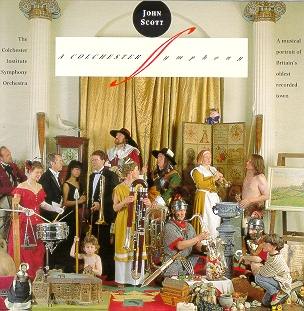
Bristol born John Scott has built an enviable reputation for himself as a composer of dramatic and evocative scores for documentaries (as well as feature films), such as the Cousteau adventures, so it is appropriate that he was commissioned to write this celebration of Britain's oldest recorded town.
The Colchester Symphony, at 66:30 minutes duration is huge and sprawling; and, it has to be said, of uneven inspiration. Bold, exciting material is let down by more ponderous elements. Try as I may, in the absence of really memorable themes, I sometimes found my attention wandering particularly in 16 minute first movement - or first tableau as the CD booklet calls it - the work is divided into five tableaux each with its own title and programme.
Tableau one entitled "Before Camulodunum" suggests the area of Colchester at the dawn of history: softly focussed and distant heraldic fanfares evoking "primordial elements drifting in the ether" and then more substantial symphonic material developing as the land forms. A sonorous celli theme is announced which is to become the motif for Colchester and from which the whole work will develop and proceed. For the first ten minutes or so we have music that represents the early dawn of civilisation and it strongly reminded me of the first movement, "Danses of des Temps primitifs" from Tournemire's Symphony No 7 , "Les Danses de la Vie" dealing with very similar subject matter. The music proceeds slowly and ponderously and might have benefited from some judicious editing; but at about 10:00 the rhythms grow increasingly urgent; there are softly touched cymbal strokes as if one hears the breath of some stirring beast, saxophone wailings, percussion beats, winding woodwinds, slithering strings, and then slight syncopations and faintly exotically Arabic inflections - all adding interest and colour as the mysticism of the Druids is invoked.
Tableau two is called, "The Romans" and it is much more arresting. It is a powerful alla marcia statement - a Respighi-like sound-portrait of advancing, mighty Roman legions. Proud and confident brass fanfares call out across the sound stage and their colour is enhanced by very authentic-sounding musical phrases evoking Latin and exotic cultures. Quieter passages suggest Celtic resignation and the verdant landscapes around the town, before an impressive fugal section evokes the building of the Roman temple.
Tableau three represents the uprising and temporary victory of Boudica against Roman tyranny.
The music harks back to some of the material in the opening movement to portray the less sophisticated rebel army drawn together by the fiery female warrior. As her forces gather the music swirls around like some swelling cloud of angry bees until at the hight of their rage they are released upon their prey. After the climax of the conflict, the music decrescendos to mourn Boudica's many casualties.
The fourth tableaux takes us forward to the Civil War with Colchester in a state of siege with Roundheads encircling the town and forcing depravation on the Royalists within its walls. Desolate tonalities comment on the hardship of the citizens. Martial music underscores armed conflict and then there is poignancy for the deaths of the Royalists who are handed over to the Roundheads as the price of the safety of the majority.
The final movement, "Celebration", is a portrait of modern Colchester. The music has all the sweep and pomp that goes with great civic pride. It is joyful and breezy, and both the everyday hurry and bustle of the town, and the contrasting serenity of its leafy green spaces and quieter paths are evoked. An attractive, Romantic, broad-flowing melody is introduced which builds up to an imposing and sustained climax which is rather let down by an anti-climactic and rather perfunctory ending after earlier material is briefly recapitulated.
An interesting if flawed work enthusiastically performed by the Colchester players.
Reviewer
Ian Lace

Howard BLAKE A Month in the Country; Violin Concerto "The Leeds"; Sinfonietta for 10 brass instruments. Christiane Edinger (violin); English Northern Philharmonia conducted by Paul Daniel
ASV CD DCA 905
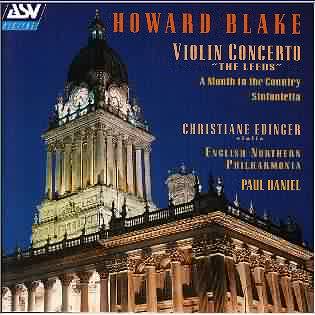
If you like lush, Romantic music, look no further. This is a magnificent, accessible concerto from the composer of the music for the highly successful animated film of The Snowman. It is the sort of music that any film producer would give his eye teeth for - dramatic, heroic, atmospheric and lyrical with beautiful soaring melodies but above all it is resolutely tonal. It was commissioned by Leeds City Council for the Leeds 1993 City Centenary, hence its title, although judging from Howard Balke's own CD booklet notes, there is no programme. It is absolute music to be enjoyed in its own right; nonetheless, one is occasionally tempted to guess at some extra musical influence - for instance, the a robust passage for brass in the lengthy first movement that might describe the forthright but dependable Yorkshire personality. Christiane Edinger rises, with aplomb, to its technical challenges, especially in the bravura third movement with its quadruple stoppings, pizzicati and dazzling broken chords. Daniels provides a thrilling and sensitive accompaniment. The sound throughout this programme is excellent.
For the 1986 Euston Films/Channel 4 film A Month in the Country, Blake wrote a sympathetic score which ideally suited this story of two former soldiers coming to terms with the horrors of the Great War amidst the serenity of the English countryside. This suite for strings contrasts lyrical, pastoral music recalling Warlock, Vaughan Williams, Delius and Finzi (yet never swamping Blake's own melodic style) with other movements suggesting soldiers' trudging marching figures, and the despair and waste of war.
The Sinfonietta for brass instruments (1981) is a brilliant and colourful work with an imposing Maestoso first movement, a technically innovative and demanding Andante and a vivacious Presto. Recommended
Reviewer
Ian Lace
tar.gif)
Brian Kay's BRITISH LIGHT MUSIC Classics Royal Ballet Sinfonia conducted by Gavin Sutherland
ASV CD WHL 2113 [70:11]
Sir Malcolm Arnold: Overture - The Roots of Heaven; William Alwyn: Suite of Scottish Dances; Sir Malcolm Sargent: An Impression on a Windy Day; Clifton Parker: Overture - The Glass Slipper; James Langley: The Coloured Counties; Gordon Jacob: The Barber of Seville Goes to the Devil; Maurice Johnstone: Tarn Hows - A Cumbrian Rhapsody; Alan Langford: Overture - Two Worlds; Sir Richard Rodney Bennett: Little Suite; David Lyon: Overture - Joie de vivre.

This is an enterprising and entertaining programme of light music by British composers many of whom have written for the screen.
Arnold's Overture: The Roots of Heaven is directly linked to the film of the same name starring Errol Flynn in his penultimate role, with Orson Welles, Trevor Howard and Juliette Greco. It was set in Africa and this Overture, written for the film's London premiere, responds to all the elements of the screenplay: elephants, the Americans and the love interest. Arnold, as usual, juxtaposes an imposing fanfare and highly evocative African sound landscape-painting with quirky, jazzy rhythms and a broad, sweeping romantic melody; a minor tour de force.
William Alwyn, of course, scored many British films, but he is represented here by his jolly Suite of Scottish dances strongly based on traditional Scottish tunes. I was especially intrigued by the second dance entitled A Trip to Italy it is as though the Cock of the North is meeting Respighi's The Birds; and by Carleton House which seems to transport the dancing to the Tyrol.
Sir Malcolm Sargent is remembered as a distinguished conductor especially by older British Promenade Concert enthusiasts, yet his An Impression on a Windy Day shows that he had considerable skills as a composer. This is highly pictorial music, supremely evocative; Sargent vividly captures the atmosphere of a wild, blustery day with music that reminds one of Mendelssohn while the more romantic elements recall Eric Coates. (Has the work a hidden programme about a pair of lovers' sometimes stormy relationship?) This is a perfect little gem that makes one wonder what Sargent might have accomplished if he had chosen to develop this facet of his talents.
Clifton Parker wrote the music for the film Sink the Bismark. His Overture to his children's operetta, The Glass Slipper, based on the Cinderella story, is included here. It is an appealing, jolly, Mendelssohnian-quick-silver, yet dainty scherzo. Gordon Jacob well known as a master arranger and orchestrator is represented by his wickedly funny The Barber of Seville Goes to the Devil a brilliant parody on the famous Rossini Overture. Considering the pathetic nag that the Barber rides, no wonder such a fate befalls him! This item is a riot and worth the price of the CD alone!
James Langley's The Coloured Counties takes its name from a quotation from a line in Bredon Hill from A.E. Housman's A Shropshire Lad: "Here of a Sunday morning, My love and I would lie, And see the coloured counties, And here the larks so high, About us in the sky." The music is nicely, hazily, evocative and lightly romantic with some rather odd Celtic inflections. But the highlight of this CD, for me, is Tarn Hows, Maurice Johnstone's Cumbrian rhapsody celebrating the loveliness of this stretch of water lying between Coniston and Hawkshead in the English Lake District. Johnstone's music magically paints Tarn Hows slowly shrugging off early morning mists, then resplendent, glistening under the midday sun to the admiration of its many visitors and then bathed in serene, spectral, moonlit beauty.
Alan Langford wrote his Two Worlds to a BBC commission. The intriguing Overture is perky and full of good humour; it is a neat combination of the elegantly classical and colourful Latin American rhythms. Sir Richard Rodney Bennett has notched up many celebrated film scores but her we have a charming set of little pieces comprising his enchanting Little Suite, its movements, for the most part, named after birds. This magical little work with its gentle waltz rhythms is comfortably and charmingly redolent of a children's world of long ago - a nice romantic nostalgic wallow. Finally there is another work principally for younger audiences - David Lyon's colourful Overture - Joie de vivre which is full of just that.
Gavin Sutherland and the Royal Ballet Sinfonia deliver sparkling and sympathetic performances of all these little gems.
Reviewer
Ian Lace

© Film Music on the Web 1998. All rights retained. Reviewers retain copyright on their reviews.
COMPETITION WIN a CD of your Choice from Crotchet

Search the Crotchet database from here
Discs on these pages are offered for sale. There is also a page of search engines from a selection of on-line retailers here.
Please support this web-site by buying your discs here.
Disclaimer: Every effort is made to make sales links to the correct disc but, in the end, you must take responsibility for checking that what you are purchasing is what you want. Some of these discs were not actually available for sale at the time of posting but a link has been made in anticipation of their forthcoming availablility.
Return to Index Page
e-mail Len Mullenger len@musicweb.force9.co.uk